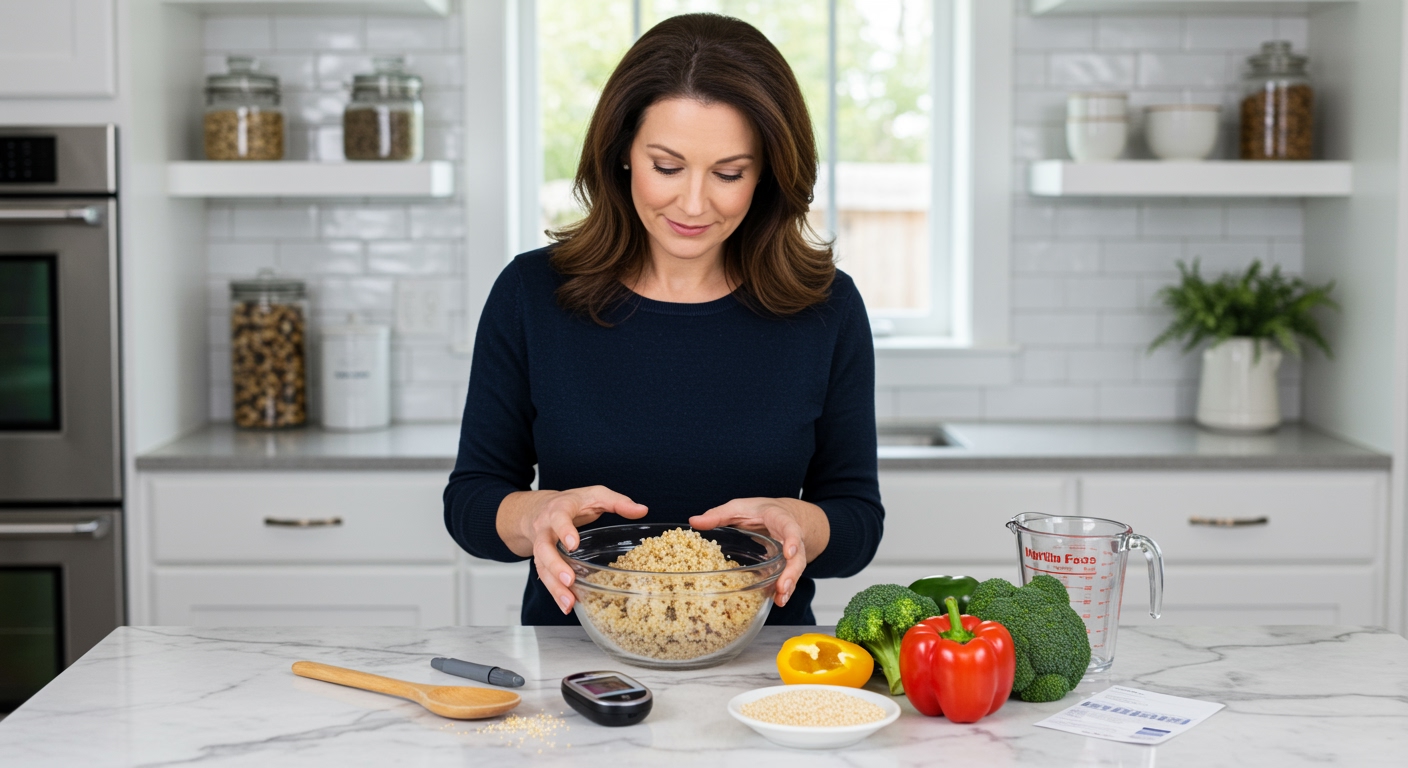✪ Key Takeaway: Quinoa is generally good for diabetes due to its low glycemic index, but portion control and timing remain crucial.
Introduction
Your doctor tells you to eat whole grains, but then you hear quinoa might spike your blood sugar.
This confusion happens because most people do not understand how different grains affect blood glucose levels. You might be wondering if quinoa is truly safe for your diabetes management plan.
Hi, I am Abdur, your nutrition coach and today I am going to explain exactly how quinoa affects your blood sugar and whether it belongs in your diabetes-friendly diet.
What Makes Quinoa Different From Regular Grains?
Quinoa is not actually a grain at all. It is a seed that comes from a flowering plant native to South America.
This difference matters because quinoa contains a unique protein profile that regular grains lack. It provides all nine essential amino acids your body needs.
The fiber content in quinoa is also higher than most grains. One cup of cooked quinoa delivers about 5 grams of fiber, which helps slow down sugar absorption.
Regular grains like white rice or wheat contain mostly carbohydrates with minimal protein. Quinoa offers a more balanced macronutrient profile that can help stabilize blood sugar levels.
The processing difference also matters. Most commercial grains undergo heavy processing that strips away nutrients and fiber. Quinoa typically requires minimal processing to reach your plate.
✪ Fact: Quinoa contains more protein per serving than any other grain or grain-like food.
How Does Quinoa Affect Your Blood Sugar?
Quinoa has a glycemic index of approximately 53, which places it in the low to moderate range. This means it causes a slower, more gradual rise in blood glucose compared to high-GI foods.
The glycemic load of quinoa is even more impressive at around 13 per serving. Glycemic load considers both the quality and quantity of carbohydrates in a typical serving size.
When you eat quinoa, your digestive system breaks down its complex carbohydrates slowly. The high fiber content creates a barrier effect that prevents rapid glucose absorption into your bloodstream.
The protein in quinoa also helps regulate blood sugar by triggering the release of hormones that signal fullness. This prevents you from overeating and experiencing dramatic blood sugar spikes.
Research shows that people with diabetes who eat quinoa experience more stable glucose levels throughout the day. The combination of fiber, protein, and complex carbohydrates works together to maintain steady energy.
However, portion size still matters. Even low-GI foods can raise blood sugar if you eat too much at once.
✪ Pro Tip: Start with half-cup servings of cooked quinoa and monitor your blood sugar response.
What Are The Best Ways To Eat Quinoa For Diabetes?
Timing your quinoa consumption can make a significant difference in blood sugar control. Eating quinoa earlier in the day allows your body more time to process the carbohydrates.
Combining quinoa with healthy fats and additional protein further slows digestion. Try adding avocado, nuts, or olive oil to your quinoa dishes.
The cooking method also influences how quinoa affects your blood sugar. Longer cooking times can break down more starches, potentially raising the glycemic response.
Cooling cooked quinoa and reheating it later creates resistant starch. This type of starch behaves more like fiber and has less impact on blood glucose.
Pairing quinoa with non-starchy vegetables creates a balanced meal that minimizes blood sugar fluctuations. The vegetables add more fiber and nutrients while diluting the carbohydrate density.
Avoid adding sugary sauces or dried fruits to quinoa dishes. These additions can quickly turn a diabetes-friendly food into a blood sugar nightmare.
✪ Note: Cold quinoa salads may have less impact on blood sugar than hot quinoa dishes.
Should You Choose Quinoa Over Other Grains?
Compared to white rice, quinoa is clearly the better choice for diabetes management. White rice has a glycemic index of 73, significantly higher than quinoa.
Brown rice offers more fiber than white rice but still has a higher glycemic impact than quinoa. The protein advantage of quinoa makes it superior for blood sugar control.
Whole wheat products vary widely in their glycemic response. Some whole wheat breads and pastas can spike blood sugar almost as much as their refined counterparts.
Quinoa provides more consistent results because it undergoes minimal processing. You know exactly what you are getting nutritionally.
The versatility of quinoa also gives you more options for creating diabetes-friendly meals. You can use it in salads, soups, breakfast bowls, or as a side dish.
However, quinoa should not be your only grain choice. Variety in your diet ensures you get different nutrients and prevents food boredom.
✪ Fact: Quinoa contains twice as much fiber as most other grains commonly eaten today.
The Bottom Line
Quinoa is an excellent choice for people with diabetes when eaten in appropriate portions and prepared thoughtfully. Its low glycemic index, high fiber content, and complete protein profile make it superior to most traditional grains.
The best foods for diabetes are not just about numbers on a chart but about how they fit into your real life and eating patterns. Quinoa offers flexibility, nutrition, and blood sugar stability that few other grain alternatives can match.
I would love to hear about your experience with quinoa and diabetes management. Have you noticed any changes in your blood sugar levels when eating quinoa? Share your thoughts and questions in the comments below.
References
At NutritionCrown, we use quality and credible sources to ensure our content is accurate and trustworthy. Below are the sources referenced in creating this article:





